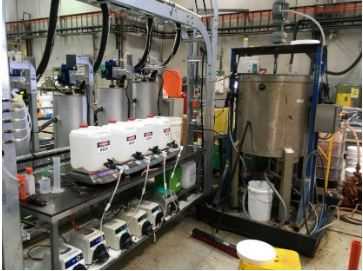Impurity removal
ALS has created and invested in a 'state of the art' Hydrometallurgical Centre of Excellence (HCE) and has a world class service capability to investigate impurity removal in all flowsheet configurations.
Hydrometallurgy is typically the process of leaching metals from ore concentrates into aqueous solutions followed by various impurity removal and concentration processes to purify and then recover these metals into their finished products. In order to offer this wide range of process optimization capability, ALS has invested a significant amount into new specialized plant and equipment to meet the demands for current flowsheet development challenges, especially around the emerging EV metals markets.
Batch equipment includes a range of temperature controlled agitated tanks with controlled gas sparging and reagent additions to controlled pH and ORP conditions.
Almost all base metals (Cu, Zn, Ni and Co) include iron as one of the many possible impurities. In addition to the iron-base metal associations, the concentration methods (mostly flotation) that are used to produce the various base metal concentrates are not perfect. Very common contaminants of these concentrates are iron sulphides, such as pyrite (FeS2 ) and pyrrhotite (FeS). The production of pure metals from typical base metal concentrates will therefore require one or more steps of selective iron removal.
The acid leaching of nickel laterites for example takes advantage of the leaching conditions (up to 250°C) that favour iron hydrolysis to rapidly precipitate the iron and release acid during the leach. The low temperature atmospheric tank leaching processes on the other hand operate under conditions that do not favour iron hydrolysis during the leach. Thus, efforts must then be made downstream to handle the relatively concentrated iron solutions.
In another example, the hydrometallurgical treatment of copper uses the selectivity in solvent extractants for copper over iron.
In some basic circuits the solubility of metal ions in acidic solutions can be controlled by simple reagent additions (neutralisation) using either Limestone or Lime additions under controlled pH and reagent addition regimes. The use of oxygen as an oxidant or Ferric are common together with reductants such as SO2 /air or SMBS for the control of ORP and precipitation chemistry.
For battery metals impurity removal has required the use of IX and crystallisation to meet the high purity specifications necessary for LiOH and PECAM production for 811 NCM.
 Search
Search
 English
English
 Login
Login
























































